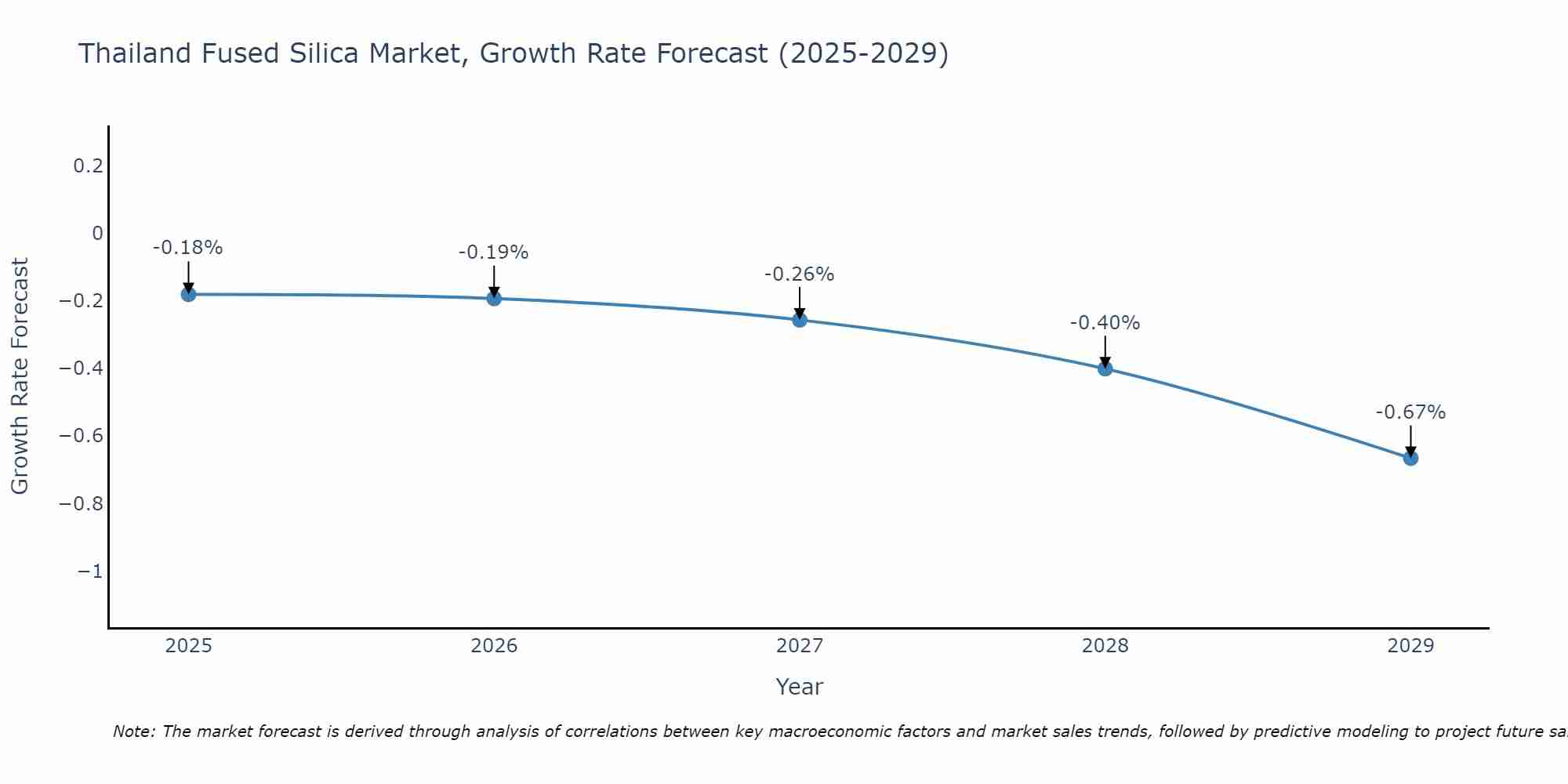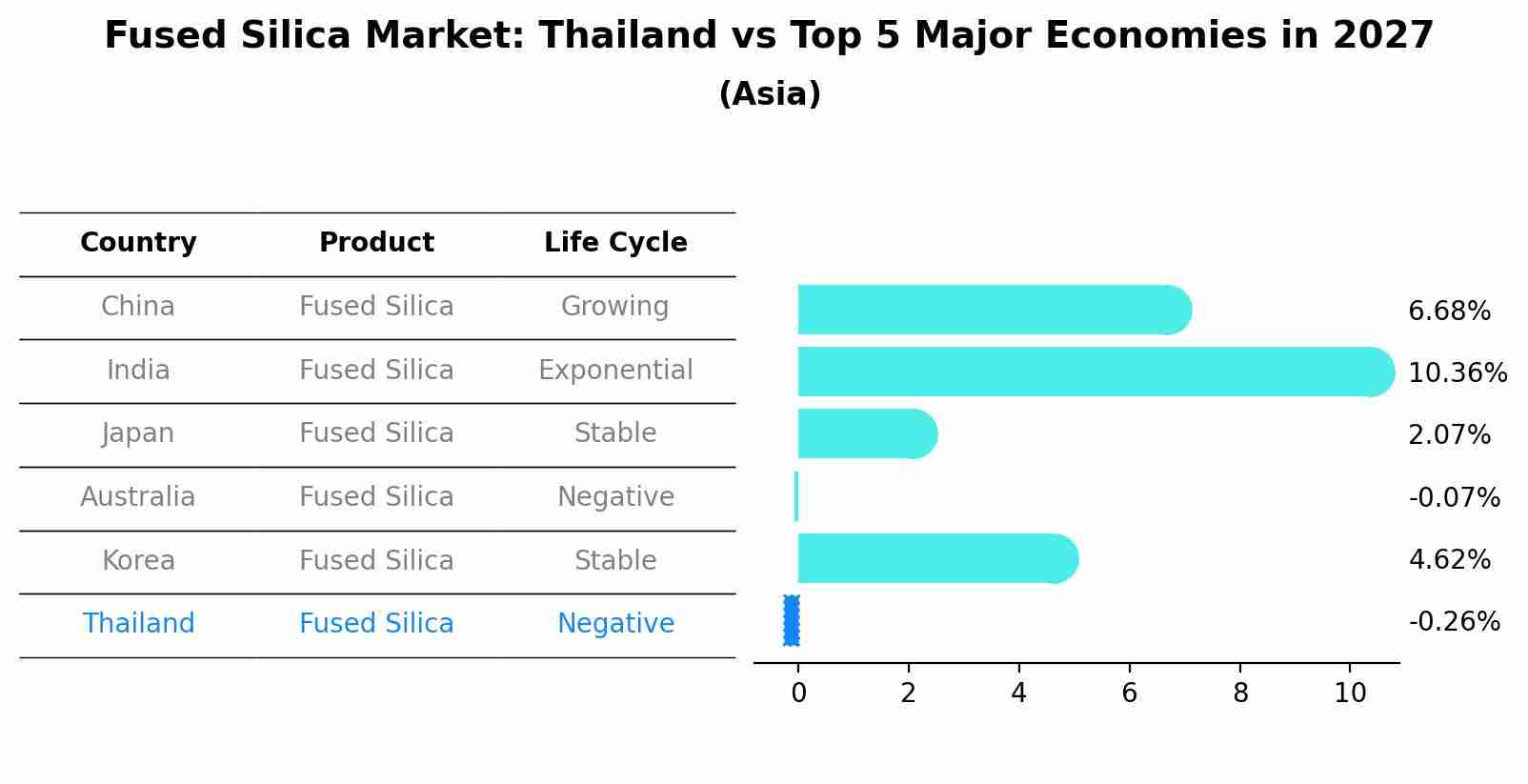Thailand Fused Silica Market (2025-2031) Outlook | Forecast, Size, Growth, Industry, Analysis, Share, Trends, Revenue, Companies & Value
| Product Code: ETC423981 | Publication Date: Jul 2023 | Updated Date: Apr 2025 | Product Type: Market Research Report | |
| Publisher: 6Wresearch | No. of Pages: 75 | No. of Figures: 35 | No. of Tables: 20 | |
Thailand Fused Silica Market Size Growth Rate
The Thailand Fused Silica Market may undergo a gradual slowdown in growth rates between 2025 and 2029. Starting high at -0.18% in 2025, the market steadily declines to -0.67% by 2029.

Fused Silica Market: Thailand vs Top 5 Major Economies in 2027 (Asia)
The Fused Silica market in Thailand is projected to grow at a negative growth rate of -0.26% by 2027, highlighting the country's increasing focus on advanced technologies within the Asia region, where China holds the dominant position, followed closely by India, Japan, Australia and South Korea, shaping overall regional demand.

Thailand Fused Silica Market Synopsis
Fused silica, a high-purity form of silicon dioxide, is a crucial material in various industries, including electronics, optics, and manufacturing. Thailand fused silica market has been growing steadily due to its diverse applications in semiconductors, photovoltaics, and optical components. The country`s skilled labor force and favorable business environment have attracted investments in manufacturing and processing facilities, further boosting the market. As technology continues to advance, the demand for fused silica is expected to rise, making it a promising industry in Thailand.
Drivers of the Market
The Thailand fused silica market is witnessing growth owing to its widespread use in the electronics and semiconductor manufacturing industries. Fused silica is a critical material for producing high-precision optical components, semiconductor wafers, and photovoltaic cells. The expansion of the electronics manufacturing sector in Thailand, coupled with the increasing demand for advanced technology products, is fueling the demand for fused silica. Moreover, its excellent thermal stability and optical properties make it indispensable in various applications.
Challenges of the Market
The fused silica market in Thailand faces several challenges that impact its growth and sustainability. Firstly, there is limited domestic production of high-quality fused silica, leading to a heavy reliance on imports. This dependence makes the market susceptible to international price fluctuations and supply disruptions. Furthermore, the stringent quality requirements for fused silica products used in applications such as electronics and optics pose a challenge for local manufacturers to meet international standards consistently. Additionally, competition from lower-cost producers in other countries puts pressure on Thai companies to maintain competitive pricing. Finally, environmental regulations and concerns about the energy-intensive production process of fused silica can impact its market growth, necessitating sustainable manufacturing practices.
COVID-19 Impact on the Market
The Thailand fused silica market faced supply chain disruptions and reduced demand during the pandemic. Industries like electronics and manufacturing, which are major consumers of fused silica, experienced disruptions in production. This, in turn, affected the demand for fused silica. However, the market showed resilience as industries adapted to the new normal and gradually increased their consumption of fused silica for various applications.
Key Players in the Market
The Thailand fused silica market boasts several major players that contribute to its growth. "Heraeus Quartz Thailand" is a leading manufacturer known for its high-purity fused silica products used in the semiconductor and optics industries. "Tokai Carbon (Thailand) Co., Ltd." is another key player, specializing in fused silica for various industrial applications, including photovoltaics and electronics. Additionally, "Nippon Electric Glass (NEG) Thailand" has a significant presence in the market, supplying fused silica for the electronics and telecommunications sectors.
Key Highlights of the Report:
- Thailand Fused Silica Market Outlook
- Market Size of Thailand Fused Silica Market, 2024
- Forecast of Thailand Fused Silica Market, 2031
- Historical Data and Forecast of Thailand Fused Silica Revenues & Volume for the Period 2021-2031
- Thailand Fused Silica Market Trend Evolution
- Thailand Fused Silica Market Drivers and Challenges
- Thailand Fused Silica Price Trends
- Thailand Fused Silica Porter's Five Forces
- Thailand Fused Silica Industry Life Cycle
- Historical Data and Forecast of Thailand Fused Silica Market Revenues & Volume By Form for the Period 2021-2031
- Historical Data and Forecast of Thailand Fused Silica Market Revenues & Volume By Grains for the Period 2021-2031
- Historical Data and Forecast of Thailand Fused Silica Market Revenues & Volume By Flours for the Period 2021-2031
- Historical Data and Forecast of Thailand Fused Silica Market Revenues & Volume By Application for the Period 2021-2031
- Historical Data and Forecast of Thailand Fused Silica Market Revenues & Volume By Investment Casting for the Period 2021-2031
- Historical Data and Forecast of Thailand Fused Silica Market Revenues & Volume By Refractories for the Period 2021-2031
- Historical Data and Forecast of Thailand Fused Silica Market Revenues & Volume By Semiconductor for the Period 2021-2031
- Historical Data and Forecast of Thailand Fused Silica Market Revenues & Volume By Glass Substrates for the Period 2021-2031
- Thailand Fused Silica Import Export Trade Statistics
- Market Opportunity Assessment By Form
- Market Opportunity Assessment By Application
- Thailand Fused Silica Top Companies Market Share
- Thailand Fused Silica Competitive Benchmarking By Technical and Operational Parameters
- Thailand Fused Silica Company Profiles
- Thailand Fused Silica Key Strategic Recommendations
Frequently Asked Questions About the Market Study (FAQs):
1 Executive Summary |
2 Introduction |
2.1 Key Highlights of the Report |
2.2 Report Description |
2.3 Market Scope & Segmentation |
2.4 Research Methodology |
2.5 Assumptions |
3 Thailand Fused Silica Market Overview |
3.1 Thailand Country Macro Economic Indicators |
3.2 Thailand Fused Silica Market Revenues & Volume, 2021 & 2031F |
3.3 Thailand Fused Silica Market - Industry Life Cycle |
3.4 Thailand Fused Silica Market - Porter's Five Forces |
3.5 Thailand Fused Silica Market Revenues & Volume Share, By Form, 2021 & 2031F |
3.6 Thailand Fused Silica Market Revenues & Volume Share, By Application, 2021 & 2031F |
4 Thailand Fused Silica Market Dynamics |
4.1 Impact Analysis |
4.2 Market Drivers |
4.3 Market Restraints |
5 Thailand Fused Silica Market Trends |
6 Thailand Fused Silica Market, By Types |
6.1 Thailand Fused Silica Market, By Form |
6.1.1 Overview and Analysis |
6.1.2 Thailand Fused Silica Market Revenues & Volume, By Form, 2021-2031F |
6.1.3 Thailand Fused Silica Market Revenues & Volume, By Grains, 2021-2031F |
6.1.4 Thailand Fused Silica Market Revenues & Volume, By Flours, 2021-2031F |
6.2 Thailand Fused Silica Market, By Application |
6.2.1 Overview and Analysis |
6.2.2 Thailand Fused Silica Market Revenues & Volume, By Investment Casting, 2021-2031F |
6.2.3 Thailand Fused Silica Market Revenues & Volume, By Refractories, 2021-2031F |
6.2.4 Thailand Fused Silica Market Revenues & Volume, By Semiconductor, 2021-2031F |
6.2.5 Thailand Fused Silica Market Revenues & Volume, By Glass Substrates, 2021-2031F |
7 Thailand Fused Silica Market Import-Export Trade Statistics |
7.1 Thailand Fused Silica Market Export to Major Countries |
7.2 Thailand Fused Silica Market Imports from Major Countries |
8 Thailand Fused Silica Market Key Performance Indicators |
9 Thailand Fused Silica Market - Opportunity Assessment |
9.1 Thailand Fused Silica Market Opportunity Assessment, By Form, 2021 & 2031F |
9.2 Thailand Fused Silica Market Opportunity Assessment, By Application, 2021 & 2031F |
10 Thailand Fused Silica Market - Competitive Landscape |
10.1 Thailand Fused Silica Market Revenue Share, By Companies, 2024 |
10.2 Thailand Fused Silica Market Competitive Benchmarking, By Operating and Technical Parameters |
11 Company Profiles |
12 Recommendations |
13 Disclaimer |
- Single User License$ 1,995
- Department License$ 2,400
- Site License$ 3,120
- Global License$ 3,795
Search
Related Reports
- Portugal Occupational Health & Safety Services Market (2025-2031) | Strategy, Consumer Insights, Analysis, Investment Trends, Opportunities, Growth, Size, Share, Industry, Revenue, Segments, Value, Segmentation, Supply, Forecast, Restraints, Outlook, Competition, Drivers, Trends, Demand, Pricing Analysis, Competitive, Strategic Insights, Companies, Challenges
- Netherlands Occupational Health and Safety Services Market (2025-2031) | Strategy, Consumer Insights, Analysis, Investment Trends, Opportunities, Growth, Size, Share, Industry, Revenue, Segments, Value, Segmentation, Supply, Forecast, Restraints, Outlook, Competition, Drivers, Trends, Demand, Pricing Analysis, Competitive, Strategic Insights, Companies, Challenges
- Belgium and Luxembourg Facility Management Market (2025-2031) | Strategy, Consumer Insights, Analysis, Investment Trends, Opportunities, Growth, Size, Share, Industry, Revenue, Segments, Value, Segmentation, Supply, Forecast, Restraints, Outlook, Competition, Drivers, Trends, Demand, Pricing Analysis, Competitive, Strategic Insights, Companies, Challenges
- Russia Women Intimate Apparel Market (2025-2031) | Strategy, Consumer Insights, Analysis, Investment Trends, Opportunities, Growth, Size, Share, Industry, Revenue, Segments, Value, Segmentation, Supply, Forecast, Restraints, Outlook, Competition, Drivers, Trends, Demand, Pricing Analysis, Competitive, Strategic Insights, Companies, Challenges
- Africa Chocolate Market (2025-2031) | Size, Share, Trends, Growth, Revenue, Analysis, Forecast, industry & Outlook
- Global Hydroxychloroquine And Chloroquine Market (2025-2031) | Industry, Trends, Size, Outlook, Growth, Value, Companies, Revenue, Analysis, Share, Forecast
- Saudi Arabia Plant Maintenance Market (2025-2031) | Industry, Size, Growth, Revenue, Value, Companies, Forecast, Analysis, Share & Trends
- Taiwan Electric Truck Market (2025-2031) | Outlook, Industry, Revenue, Size, Forecast, Growth, Analysis, Share, Companies, Value & Trends
- South Korea Electric Bus Market (2025-2031) | Outlook, Industry, Companies, Analysis, Size, Revenue, Value, Forecast, Trends, Growth & Share
- Africa Low Temperature Powder Coating Market (2025-2031) | Companies, Competition, Size, Challenges, Segmentation, Trends, Competitive, Industry, Supply, Strategy, Investment Trends, Growth, Segments, Restraints, Strategic Insights, Revenue, Share, Forecast, Drivers, Analysis, Pricing Analysis, Demand, Consumer Insights, Value, Opportunities, Outlook
Industry Events and Analyst Meet
Our Clients
Whitepaper
- Middle East & Africa Commercial Security Market Click here to view more.
- Middle East & Africa Fire Safety Systems & Equipment Market Click here to view more.
- GCC Drone Market Click here to view more.
- Middle East Lighting Fixture Market Click here to view more.
- GCC Physical & Perimeter Security Market Click here to view more.
6WResearch In News
- Doha a strategic location for EV manufacturing hub: IPA Qatar
- Demand for luxury TVs surging in the GCC, says Samsung
- Empowering Growth: The Thriving Journey of Bangladesh’s Cable Industry
- Demand for luxury TVs surging in the GCC, says Samsung
- Video call with a traditional healer? Once unthinkable, it’s now common in South Africa
- Intelligent Buildings To Smooth GCC’s Path To Net Zero













